
Tim Flannery’s Yearning for Climate Commissars
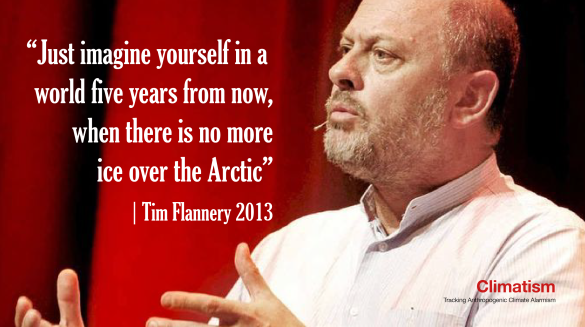
Tim Flannery’s new book The Climate Cure is a spin-riddled, stocking-filler for his green-left fan club that will persuade nobody else and reveals the astonishingly anti-democratic, authoritarian streak that seems to characterise all the most ardent advocates for ‘climate action’.
Flannery has been at the forefront of advocacy for action on climate change at least since his 2005 best seller The Weather Makers. The Gillard Government appointed him to chair its Climate Commission, which the Abbott Government abolished following its election in 2013. He morphed it into the Climate Council, funded by donations, and speaks and writes frequently on climate change issues in Australia and internationally.
In his latest book — full title: The Climate Cure: Solving the Climate Emergency in the Era of COVID-19 — Flannery says, “the response to the pandemic provides us with a roadmap for dealing with the climate crisis.” That roadmap has three elements, based on the former paleontologist and full-time alarmist’s analogy likening the coronavirus and greenhouse gas emissions from the use of fossil fuels.
His prescriptions: firstly, “cutting fossil fuel use, decisively and deeply,” which he likens to containing the spread of the virus. Secondly, minimising the damage from greenhouse gases in the atmosphere already, or which we can’t avoid emitting in future. He likens this to building critical health care capacity. And thirdly, developing “a new, clean economy with the capacity to draw CO2 out of the air at scale,” which he likens to developing a vaccine.
Flannery outlines in the first part of the book Australia’s climate paradox: our endowment of fossil fuels and our vulnerability to climate change. He draws a straight line from Bob Menzies insistence in 1938 that Australian pig iron be shipped to Japan and Germany, with whom we would soon be at war, with our current support for coal and gas, from which he claims we reap only “limited wealth.” This is typical of the spin and distortion that infect the book. Coal and gas are Australia’s second- and third-most valuable exports, behind iron ore. Together they generate about $100 billion a year in export earnings.
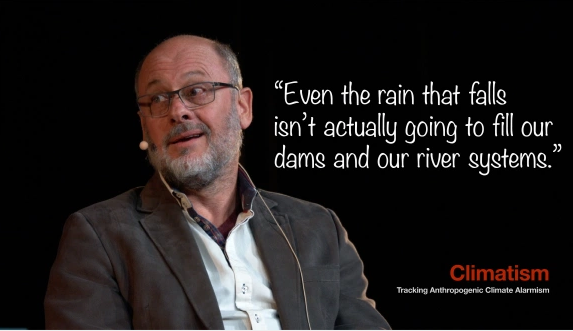
Flannery’s synopsis of the politics of climate change since the Howard years is as partisan as you would expect. The lesser enemies are Tony Abbott, Barnaby Joyce and the ‘deniers’ in the Coalition, talk-back hosts like Alan Jones and, inevitably, the Murdoch press. But “the real enemy is the fossil fuel industry.” He struggles with the issue of forgiveness, which Christine Figueres, UN executive secretary for climate change during the Paris agreement negotiations, says is essential to letting go of the fossil fuel dominated past. But Flannery is far from up to it, branding the fossil fuel industry a “parasite on the economy” on the basis of the beat-up claim that it is heavily subsidised. The exemption from fuel excise of diesel for off-road use is the lion’s share of these so-called subsidies, despite which, Australian governments raise a lot of revenue from fossil fuels through royalties, excise, company tax, and GST. And Australians routinely use the products of this industry in every aspect of our lives. Less a parasite than the life blood of our economy and society.
Flannery warns against focussing on issues like population growth, meat-eating, and other individual action, because it just lets fossil fuel companies off the hook. “The real battlefront,” he says, “lies in the boardrooms and marketplaces of the fossil fuel companies.”
It goes without saying that Flannery has no time for the Morrison government’s gas-led recovery, nor any of its climate and energy policies. He points to a revolving door between ministerial suites and fossil fuel companies and lobby groups, citing Labor’s Martin Ferguson and the Liberals’ Ian MacFarlane. Condescendingly, he thinks coal-dependent communities are composed of simpletons easily duped by politicians into thinking they will have nothing without coal. If only governments implemented measures, which Flannery doesn’t specify, that would “assist the coal-dependent communities to transition to a more prosperous future”. Like all his breathless talk of a cleaner, healthier, more prosperous future underpinned by renewable energy, there is little substance.
Like almost everyone in the climate push, Flannery says its essential we act now, as it is our last chance to avoid catastrophic climate change. “We must cut emissions globally by at least 7.6 per cent per year for the next decade,” he chants even while admitting no country has ever achieved anything like that.
Never one to miss jumping on the panic du jour, Flannery devotes a chapter to Australia’s “megafires” of 2019-20, saying “every day the coal fires burn … we’re effectively increasing the severity of the fires of tomorrow.” Predictably, he is dismissive of hazard-reduction burning as a mitigation measure, salting his disaster porn narrative with the claim that “some medical researchers fear that the consequences of smoke exposure from this year’s fires will be felt for generations.” He uses the fires to paint a picture of the enormous costs of climate change, citing estimates that put the cost of the fires at $100 billion. But at 5 per cent of GDP, it’s an implausibly large number for fires that killed 134 people, destroyed fewer than 6,000 buildings and yet only shaved GDP growth, implying substantial larding of the estimates with nebulous intangible losses. He then points to work by The Economist that the world economy might be 3 per cent smaller overall than it might have been due in 2050 to the impacts of climate change. With global GDP growth of around 3 per cent per year, that is very far from scary.
Flannery’s taste for taking decisions away from democratically accountable politicians is revealed when he recommends that a Commission for Primary Production, to “operate at arm’s length from government,” be “given the funds currently used for drought relief, and tasked with preparing Australia’s primary producers for the challenges of the future.” Money would be taken from desperate farmers trying to survive drought and given to well-remunerated commissars charged with whipping them into climate shape!
After misrepresenting the cause of massive bushfires, any student of Flannery’s record would expect mention of the Great Barrier Reef and its alleged looming doom. One quote worth bookmarking for future ridicule, alongside his infamous prophecy that dams would never fill again, is this:
Put simply, it’s unlikely that the Great Barrier Reef, in its present state, can survive more than 1.5 °C of warming, and the greenhouse gases already in the air are likely to drive temperatures to this point within the decade.
Sea level rise comes in for the same kind of catastrophising treatment.
A recent study has estimated that within eighty years, if we continue on our current polluting course, half the Earth’s sandy beaches will disappear, with 12,000 kilometres of the Australian coastline affected.
Need it be said that Flannery is a fan of Zali Steggall’s proposed climate bill and is particularly taken with its anti-democratic approach of holding governments legally responsible for achieving climate targets “regardless of how ambitious they are”? And, presumably, regardless of how traumatic they are to Australians. He also likes the idea of an “independent Climate Commission to hold government to account,” unsatisfied with the democratic idea of citizens holding government to account.
The second part of the book sets out Flannery’s three-part cure, based on his coronavirus analogy.
The COVID-19 pandemic has taught us that the first step in dealing with an emergency is to stop the spread of its cause. In climate terms, that means cutting fossil fuel use hard and fast.
He envisages a tough battle with the fossil-fuel lobby, “a fight to the death of our planet as we know it.” Flannery proposes that we immediately begin to reduce Australia’s greenhouse gas emissions by “at least 8 per cent per year, every year, until 2030.” He describes the investment required as “moderately large.” Flannery repeats ad nauseam the line that renewable energy is the cheapest new energy source in Australia, and that more wind and solar power will lower prices for consumers.
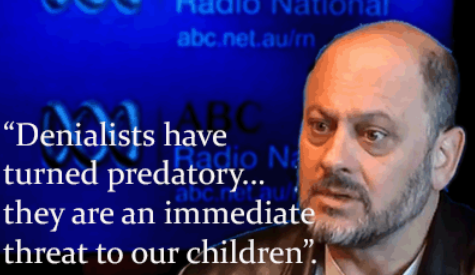
Flannery denigrates the coal-fired generators that have powered Australia’s grid for decades, and still provide about 56 per cent of our electricity. He writes off gas as a transition fuel as but one of a number of “potent lies propagated by the sceptics,” claiming South Australia is “the real test case” and saying that mendicant state’s embrace of renewables has not resulted in it burning more gas. But Flannery’s comparison of 2007 with 2019 presents a false narrative, comparing a system dominated by coal and gas (86 per cent) to one without coal, split between gas and renewables (50 per cent each). Since South Australia’s coal-fired Northern Power Station closed in May 2016, gas-fired generation has increased by 46 per cent, even as renewables output has increased by nearly 40 per cent.[i] Intermittent renewables have displaced the coal-fired generation in South Australia, but not the responsive gas-fired generation and interconnector supply needed to back them up. According to the Australian Energy Market Operator (AEMO):
Despite the relatively strong penetration of renewable energy and battery storages, gas-powered generation (GPG) remains a critical source of firming supply and at times provides almost 100% of the electricity demand in South Australia when renewable generation is not available.[ii]
In October 2020, for example, from about 6:30 pm on the 18th until about 6:30 am on the 24th, gas continuously provided more than 500 MW of output, and reached nearly 90 per cent of total output at 4 am on the 20th, due to a week of relatively low winds and the nightly inability of solar to produce. Flannery’s claim that South Australia’s big Tesla battery undercuts gas is laughable – the battery can deliver only 150 MW for just an hour and a quarter. This can provide some grid stability, but it does not even begin to come close to replacing what gas did for South Australia in that low-wind week in October.
Apparently, baseload power is “a Soviet-era concept … that is vanishing, or has vanished, globally:
Fortunately, renewable power from wind and solar, coupled with storage, and consumer demand management, can provide all the flexibility and variability that’s needed, as well as combine to provide the 24/7 needs of industry…
Modern grids with distributed suppliers are able to supply cheaper, more reliable and far cleaner electricity than old baseload grids.
He offers no substantive example or reference to back this claim. Although many renewables advocates are saying it can be done, and researchers, regulators, and utilities are doing modelling and analytical work as they grapple with renewables’ growing penetration and on-again/off-again disruption of the grid, Flannery’s articulation of these assertions as if they were demonstrated facts significantly distorts the reality. Designing, building, and managing such grids at scale to be reliable under a wide range of conditions presents substantial engineering challenges that can’t be just waved away with glib talk of “smart grids,” to say nothing of the costs. For example, AEMO comments it “may no longer have the means to operate a South Australian island securely at times of high distributed PV [photo voltaic] generation. Security risks will grow rapidly as more distributed PV is installed”.
Yet Flannery dismisses as a delaying tactic the idea that we need an orderly transition of our electricity system. He counters that the most orderly transition is where “strong government policy moves the nation at top speed away from fossil fuels,” and asserts that “by 2030 Australia’s electricity supply could come almost entirely from renewable sources.” For a reality check, consider that for all the investment in renewables in recent years, the share of electricity generated by fossil fuels declined by only 7 percentage points, from 86 per cent in 2015 to 79 per cent in 2019.
Flannery has a four-point plan for how this transition could occur. It includes an additional 31,000 MW of wind capacity. That’s more than 10,000 additional 3 MW turbines, or about 100 new mega wind farms. Next, a six-fold increase in solar farm capacity to 16,000 MW, or about 100 new large solar farms. Then, more than tripling the roof-top solar capacity to 35,000 MW. Finally, an 800 MW transmission line from SA to NSW, with other lines from Tasmania to Victoria, and in north Queensland. Flannery presents no analysis of how all this could be built in as little as a decade, but boldly declares that if “Australians were to set a goal of 100% renewable energy by 2030, we will achieve it.” Australians might also want to know where all these projects are going to be sited. Apart from Snowy 2.0, Flannery doesn’t mention any new storage capacity, even though the study he draws the plan from says that to “help match supply and demand on a 30-minute basis for most days over the three-year period, it was found that 24GW/81GWh of short-term storage was required.”[iii] That is equivalent to around a hundred of the four pumped-hydro storage projects being considered for funding by the Australian Renewable Energy Agency, or several hundreds of big batteries like the one in South Australia. In any event, the study is a modelling exercise using scaled and simulated data, assumes all generation can be transmitted, and it’s not clear how any storage or other losses are treated.
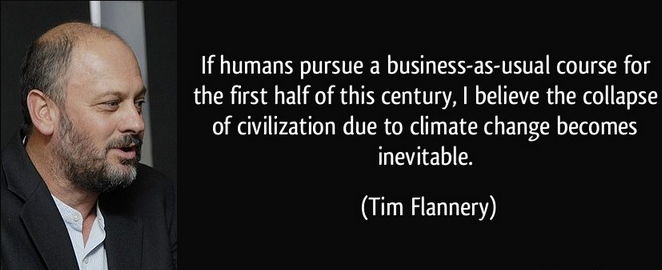
As Flannery’s renewables plan creates a promised “new age of clean prosperity for Australia,” he wants social justice so that the transition leaves no Australian behind. He is critical of Bob Brown’s 2019 convoy to Queensland’s Galilee Basin, and says instead that:
Environmentalists need to listen to the communities in the coal and gas basins, to reassure them that they and their economic welfare really count, and to begin exploring together ways to ensure a better future.
Germany’s Coal Compromise, a two-decade long plan agreed in early 2019, is his model. Though it can’t have many runs on the board yet, Flannery is sure it will see workers who lose their mining jobs re-hired as their regions become “centres of a diversified economy that includes clean energy hubs, tourism and environmental remediation.” On industrial greenhouse gas emissions, Flannery says the Morrison government’s safeguard mechanism has “failed dismally,” because industrial emissions have grown substantially, driven by the ramp-up of natural gas exports. He launches into a denigration of this industry, criticising the energy consumed in liquifying the gas, the emissions generated by its end use, the claimed impacts on water and agriculture, fugitive emissions from its extraction, and noting that exports have raised prices in Australia, and that oil and gas companies are prominent among the large companies that “pay no tax” in Australia. Flannery moves on to talk about cutting off the support network for fossil fuels by pressuring investors, financiers, boards, insurers and others to boycott the industry.
Having blithely dismissed Australia’s fossil fuel industries, which generate nearly 80 per cent of our electricity, fuel our economy, and earn about $100 billion a year in export revenue, Flannery knows he has to come up with more than just a renewable electricity system. His answer is hydrogen, which he says, “can replace all fossil fuels.” Most industrial hydrogen is now produced by steam reformation of natural gas. Flannery hydrogen-powered vision relies instead on the electrolysis of water using renewable electricity.
In Flannery’s narrative, this “clean hydrogen” is a miracle fuel that can readily be produced, stored, transported, and used in a myriad of ways throughout the economy. He pays no heed to the engineering, safety, scale, economic, or skills and training challenges. For example, having pilloried the natural gas industry for consuming significant energy to liquify gas at temperatures of around -160 °C, Flannery ignores the bigger challenge of liquifying hydrogen at temperatures below -240 °C. Hydrogen is a very small and highly reactive molecule. Precision joints and carefully selected materials are involved in its handling under extreme cryogenic temperatures and considerable pressures. It can embrittle steel, reducing strength and ductility, which can result in cracks and fractures. We are a long, long way from seeing tanker trucks delivering it to service station and cryogenic jerry cans. That’s why it’s only used in specialist applications requiring its unique properties, such as rocket fuel.
Flannery enthuses about one German steelmaker that used some hydrogen in a 2019 trial, reducing its use of coke by a third. Flannery spins this to imply that converting a huge global industry to new hydrogen-based production can happen quickly, easily and without increasing steel prices. With our iron ore and our solar energy resources, Flannery says:
Any Australian Government worth its salt would be doing all it could to kick-start a renewable hydrogen-fuelled iron-ore-to-pig-iron industry in the Pilbara.
But Flannery is conspicuously silent about BHP’s infamous Hot Briquetted Iron plant, which opened in 1999 near Port Hedland, and is as relevant a case study as could be asked for. In this plant, the iron ore was exposed to heat and hydrogen and carbon monoxide gases, removing oxygen to produce metallic granules that were then compressed into briquettes. One consultant is reported to have said that, “solids and liquids in the same plant are not hard to manage, even at high temperatures, but solids and gases are very difficult.”[iv] In 2004, an explosion occurred and the investigation found that “the accident was caused by a series of dust explosions, at least one of which was initiated and stimulated by hydrogen.”[v] BHP announced in 2005 it would permanently close the plant, citing the cost of the further investment involved and “the failure to consistently achieve the financial and technical targets.” But, according to Flannery, “so good are the prospects for steel made using hydrogen” that we “cannot afford to ignore this opportunity,” citing a Grattan Institute suggestion that “Australia should set out to capture 6.5 per cent of the global steel market, which would generate $65 billion in annual export revenue.” This would imply a twentyfold increase in Australia’s steel production, from about 5.5 million tonnes a year to around 120 million tonnes a year.
Never one to limit the horizons of his green imagination, Flannery foresees a revolution in transport, driven by electric and hydrogen vehicles, and he is particularly enthusiastic about laser-guided, trackless trams for 300-500 passengers, which “carry their own batteries that can be recharged in thirty seconds while travelling, or in ten minutes at the end of their journey.” Of course, he’s excited about electric cars, Tesla, and the increasing number of European models being developed. And critical of the Australian Government’s lack of policy support. In addition to rapidly eliminating diesel busses, he wants a national electric vehicle study, a Productivity Commission review of vehicle taxes, tax deductions for solar/storage, electric vehicle targets for government fleets, and a new “Federal Office of Electric Vehicles”.
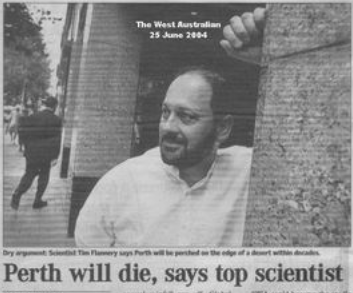
Flannery acknowledges aviation will remain dependent on fossil fuels for some time, and that electric planes have limits, but is optimistic that biofuels and “e-fuels” can provide a solution. “E-fuels are jet fuels made from atmospheric CO2 and hydrogen that have been generated by using clean energy.” Again, early trials are extrapolated into purported solutions for a major global industry. He wants Australia to have all domestic flights running on e-fuel by 2030. For shipping, Flannery says “the best solution … currently appears to be hydrogen.” Again, there’s no acknowledgement of any technical, safety or operational challenges. Consider, for example, a hydrogen leak at sea, or a ship collision, and a possible catastrophic fire or explosion. Yet Flannery is typically glib: “The basic technologies required to move from bunker fuel to hydrogen exist today.”
Flannery discusses the global climate policy scene and the difficulties presented by the win-lose attitudes of participants. In his imagination the miracle of ‘almost free’ renewable electricity comes to the rescue, creating a new “win-win” world, bypasses entrenched battles around historical responsibility for greenhouse gas emissions and compensation. That’s the thing about unleashed imagination: everything and anything is possible if you will it.
The second stage of Flannery’s cure is adaptation, which he likens under his coronavirus analogy to developing “the equivalent of ‘emergency rooms’ (ERs) to shelter the worst affected of Earth’s ecosystems, as well as to assist the worst affected human populations.” He wants a reinstated National Climate Change Adaptation Research Facility. He also wants a national adaptation policy to be “used as a sieve” for government infrastructure investment. Megafires and heatwaves feature strongly in his narrative, and he makes the claim that “heatwaves kill more Australians than any other natural cause.” He rejects building dams as a solution to Australia’s rainfall variability. And, confirming his anti-democratic attitudes, Flannery wants “a properly constituted, apolitical National Commission for Climate Adaptation,” and a “Coastal Defence Fund … administered by experts…” He also wants changes to laws to allow “those suffering damage from climate change to sue those who are accessory to inflicting it on them.” It feels like he wants to make you liable for prosecution as an accessory if you don’t agree with him.
The third and final stage of Flannery’s cure is the drawdown of CO2 from the atmosphere, which he calls “a vaccine for the fossil fuel pandemic.” He acknowledges that planting trees is unlikely to be the solution, because the scale of the problem overwhelms land availability and tree growth rates. As with accelerated development of a vaccine for the coronavirus, Flannery says we will need to invest
invest billions in the development of a ‘climate vaccine’ consisting of technologies that can take greenhouse gas CO2 out of the air
He has four candidates: seaweed covering vast areas of the world’s oceans; silicate rocks that sequester CO2 as they weather; carbon-negative materials ranging from innovative concretes to planting urban forests; and the direct air capture of CO2. As with the rest of his narrative, the tone is wildly optimistic extrapolations from research and early pilot trials.
Roger Scruton’s book The Uses of Pessimism: And the Danger of False Hope provides a thorough critique of the kind of optimism that pervades Flannery’s book. “Unscrupulous optimists”, writes Scruton, “believe that the difficulties of humankind can be overcome by some large-scale adjustment: it suffices to devise a new arrangement, a new system, and people will be released … into a realm of success.” Scruton discusses the fallacies and defences against the truth used by such glad-handing spruikers, and all are present in Flannery’s book.
Flannery’s book also provides a good case study of Scruton’s defences against the truth. Onus shifting, blaming our climate situation on the fossil fuel industry rather than accepting our collective participation in the modern, high-energy society it enables. False expertise, in which “the strategy is to invent experts, backed by all the apparatus of scholarship, research and ‘peer review,’ and … designed to bury a foregone conclusion in a mound of pseudo-scholarship.” A large number of Flannery’s references are to stories published by the ABC, the Guardian, the Conversation, or reports by activist organisations like Renew Economy, Climate Works, or his own Climate Council. Scruton’s third truth-avoiding strategy involves “not defending one’s position, but concealing it within a fortified citadel of nonsense.” For example, Flannery ignores Michael Shellenberger’s substantive critique that renewables are unreliable and energy-dilute, which no amount of innovation can transcend, hiding behind his belief that zero-emissions, renewable electricity can be reliable and almost free, and elaborating on that miracle with tales of a range of technologies in their pilot state at best, which he says or implies can be quickly and successfully scaled up to eliminate fossil fuels. And Scruton’s fourth truth-avoiding strategy is scapegoating. Flannery’s most obvious scapegoat is the Morrison government. Yet in his anti-democratic embrace of rule by experts lurks another – the citizens of Australia, who are implicitly blamed for electing Coalition governments.
Flannery’s analogy between the coronavirus and greenhouse gas emissions works as an organising principle for his narrative, even though it irks that he frames as a virus the use of fossil fuels that since the 19th century have liberated millions from hard physical labour and poverty. But he admires other aspects of the pandemic response too. He wants to put authority in the hands of commissions of experts who would set about a complete and rapid transformation of our economy and society. His narrative makes no allowance for problems, let alone failures, along the way. Nor does it countenance that Australians might protest the things his cure would impose on us (such as a mega wind farms) or the dislocations, disruptions, discomforts and costs we might be expected to endure.
The Climate Cure is Flannery’s green-left catechism for the faithful, full of exaggerations, distortions, myths and endless rhetoric of a “new age of clean prosperity for Australia.” It ignores critiques of his renewables-only approach, about which he is absurdly optimistic. And if that is not enough, he places his massive societal transformation of Australia into the hands of commissions of experts – climate commissars just like him. Blackouts will be the least of our problems if he gets his way.
Dr Michael Green has a PhD in Systems Engineering.
The Climate Cure: Solving the Climate Emergency in the Era of COVID-19
Tim Flannery
Text Publishing, 2020, 165 pages, RRP $24.99.
[i] 2018-19 compared with 2015-16, author’s analysis using data from Department of Industry, Science, Energy and Resources, Australian Energy Statistics, Table O, September 2020.
[ii] AEMO, South Australian Electricity Report, November 2020.
[iii] David Oswald, “How to run the national electricity market on 96 per cent renewables,” Renew Economy, March 2020.
[iv] Australian Financial Review, “BHP tries to squeeze its iron lemon both ways,” Oct 27, 2000.
https://www.afr.com/companies/bhp-tries-to-squeeze-its-iron-lemon-both-ways-20001027-kb731
[v] BHP Billion Fact Sheet, Boodarie Iron, August 2005.
https://www.bhp.com/-/media/bhp/documents/investors/news/hbifactsheet.pdf?la=en
Academics and others who dare to question the majority view are brutally told the science has been settled. Many such dissenters from catastrophist orthodoxy have lost their jobs, been denied promotion, or subjected to constant harassment and ridicule. This not the way science should be done
Aug 25 2024
3 mins
There's a veritable industry of academics raising alarm about how global warming and a polluted, dying planet will leave humanity and the animal kingdom in such a state that cannibalism will be a matter of survival. I'll spurn schoolyard puns and cheap gags except for one, and that by way of good advice: don't give them a big hand
Aug 09 2024
13 mins
I thought initially that this topic was a bit of fun. But it turns out that entomophagy, as the eating of insects is called, is an essential component of the Western lemmings' race to net-zero. Need it be said that one of the biggest and most enthusiastic lemmings is our very own climate crazies at the CSIRO?
Jul 31 2024
15 mins







